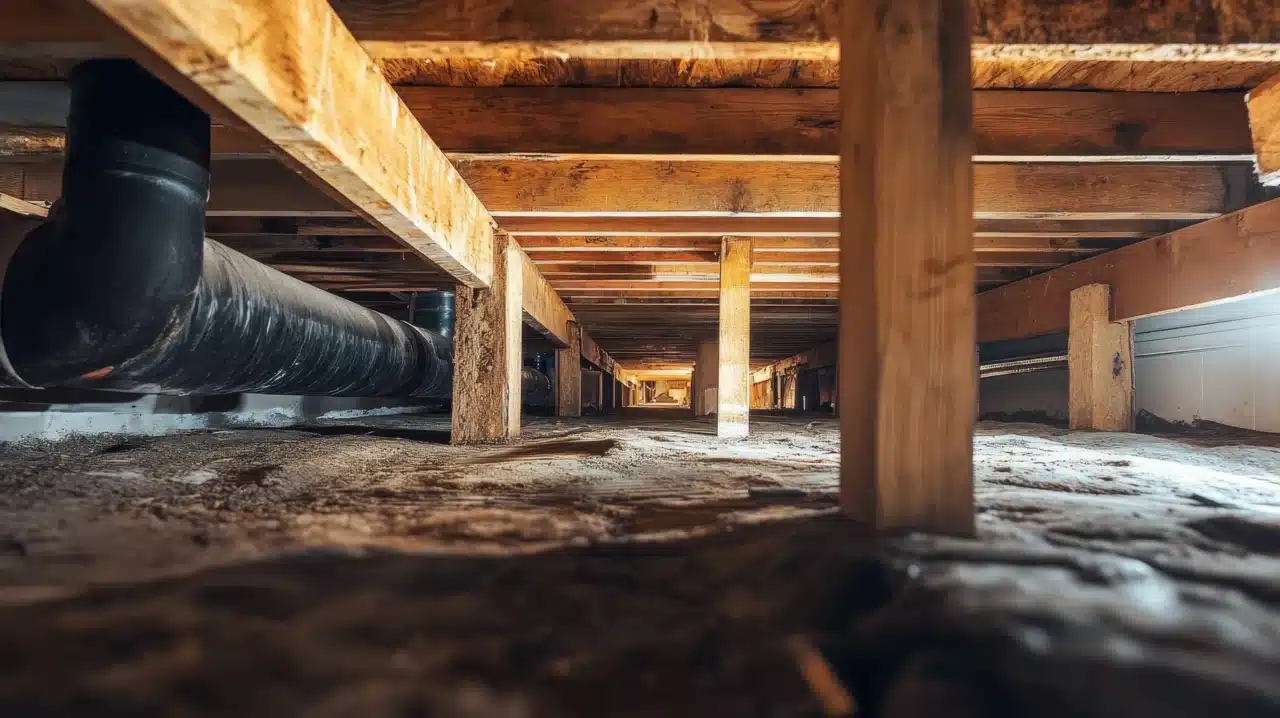In the Southeast, moisture doesn’t sneak into your crawl space. It steamrolls in. Between swampy summer air and flash floods, it’s no wonder you’re dealing with cupped floors, that damp sock smell, or mildew blooming up your baseboards.
We help thousands of homeowners across Tennessee, Kentucky, Georgia, and Alabama get that moisture under control. In this guide, we’ll show you what a healthy crawl space humidity level looks like and how to keep damp conditions from damaging your home.
Why Crawl Space Humidity Matters
When humidity builds in a sealed crawl space, warm air hits cooler surfaces and condenses, creating droplets that fall like rain. That’s called crawl space condensation. It’s almost like your home is sweating from the inside.
And once moisture gets in, it triggers a chain of crawl space problems. Some are obvious. Others hide beneath your feet until they get extremely expensive. Here’s why controlling crawl space humidity matters:
Preventing Mold and Mildew
That stale, wet-sock smell creeping through your home probably isn’t the laundry. Once relative humidity hits 60%, mold buildup becomes a possibility.
Mold spores thrive under your house and circulate through your heating and air conditioning system, circulating through your home and affecting your indoor air quality.
For families with asthma or allergies, this can become a serious health risk. Crawl space moisture control helps keep those spores out of your breathing space.
Protecting Structural Integrity
Moisture and wood are a bad combo. When wood reaches 30% moisture content, decay sets in. That means your subfloor, joists, and framing (the bones of your house) can start softening and failing from the bottom up.
It doesn’t take decades, either. In hot, humid states, a single season of neglect can kick off years of slow structural decline.
Avoiding Pest Infestations
If it’s damp, dark, and quiet, pests might be moving in. Rodents, termites, ants, cockroaches, mosquitos … they all love humid crawl spaces.
Once they’re in, they chew through wood, burrow into insulation, and reproduce fast. Pest control plus crawl space repairs equals big bills. Proper crawl space maintenance and keeping that area dry is how you stop infestations before they ever begin.
Ideal Crawl Space Humidity Levels
The best humidity level for crawl space longevity is between 30% and 50%, max. Above that, you risk rot, mold, and infestations. Too low, and things dry out in all the wrong ways.
But hitting that number once isn’t enough. You need to keep the air beneath your floors steady through heat waves, cold snaps, and everything in between.
Optimal Humidity Range
That 30% to 50% sweet spot exists for a reason. It reflects how much water vapor the air holds. At this level, the wood in your subfloor won’t absorb excess moisture and swell, and it won’t dry out and crack, either. Mold spores stay inactive, and pests don’t get the damp environment they’re looking for.
It’s also the level where your Heating, Ventilation, and Air Conditioning (HVAC) system doesn’t have to overcompensate for soggy insulation or dry, leaky gaps. When your crawl space stays balanced, your whole home runs more efficiently.
Crawl space encapsulation, vapor barriers, and dehumidifiers all work together to help keep things in check. The goal is consistency. And in the Southeast, where the weather flips overnight, keeping your crawl space humidity level stable year-round is the secret to a healthier, problem-free home.
Seasonal Variations
Summers in Tennessee, Alabama, Georgia, and Kentucky often come with 90°+ heat and humidity that clings like plastic wrap. Your crawl space soaks it all in. That’s when humidity spikes and problems explode.
But cooler months bring their own issues. Humidity drops, but if you’re seeing condensation or uneven floors, your insulation might not be doing its job.
Watch your crawl space every season. Humidity doesn’t take time off, and neither should your crawl space moisture control plan.
Risks of High or Low Humidity
We’ve already covered the potential for mold, rot, and pests that thrive on excess moisture. But what about the other extreme?
When crawl space humidity drops too low, things get brittle. Dry air can lead to cracked wood, gapping floorboards, static shocks, and air leaks that hike up your utility bills.
Don’t strive for zero humidity. Strive for balance. Too much moisture and your crawl space becomes a breeding ground. Too little, and your house starts breaking down from the inside out.
How to Monitor Crawl Space Humidity
If you want to stop crawl space issues before they spiral into costly repairs, you need to know what’s going on down there year-round. Because when the air under your house swings too far in either direction, you don’t just feel it… you pay for it.
The first step to crawl space moisture control is simple: start tracking the crawl space humidity level before it gets out of hand.
Humidity Sensors and Hygrometers
You don’t need a contractor to figure out your humidity levels. A digital hygrometer or smart humidity sensor does the trick.
Stick with models designed for basements or crawl spaces, ideally with remote access, so you can monitor things without crawling around in the dark. Expect to spend anywhere from $15-$60.
Place the sensor midway between the floor and ceiling of your crawl space, away from vents or HVAC lines that could skew the reading. One sensor is fine for smaller areas, but if your crawl space stretches under the entire length of your house, use two.
Check readings weekly. If it consistently creeps above 55%, it’s time to intervene.
Signs of Excess Moisture
Even without tools, your home will let you know when something’s off. Signs of excess moisture include:
Musty or sour “basement” smells drifting into your living space.
- Hardwood floors that feel warped underfoot.
- Rust on ductwork or vents.
- Condensation on pipes or insulation in the crawl space
- A sticky, heavy feeling in the air despite running your air conditioner.
- Visible standing water under the house.
If you’re noticing any of the above, your crawl space is holding too much moisture.
Effective Ways to Control Crawl Space Humidity
Moisture doesn’t resolve itself without intervention. You need the right strategy to keep crawl space humidity levels from spiking every time it rains, the air conditioning kicks on, or the weather swings 30 degrees overnight.
Here’s what actually works and where most homeowners get it wrong:
Vapor Barriers
A vapor barrier is thick plastic sheeting that gets installed across the crawl space floor to block moisture from seeping up through the ground. It’s one of the easiest, most effective ways to prevent water vapor from turning your crawl space into a damp mess.
The industry-backed method is a 6-mil polyethylene barrier, laid wall to wall, with seams overlapped by at least 12 inches and sealed airtight.
The material should also run 6 inches up the walls of your crawl space and be securely fastened in place. If you want it to do its job, make sure there are no gaps and no folds (i.e., no shortcuts).
Where do DIYers mess this up? They skip the tape. Or they don’t extend the barrier far enough up the walls. Or they use flimsy plastic that pulls away or tears shortly after installation.
Crawl Space Encapsulation
Encapsulation is the gold standard if you want full crawl space moisture control. This isn’t just laying plastic. It’s sealing the entire crawl space … walls, floors, vents, everything.
Encapsulation typically involves heavy-duty polyethylene sheeting (12 to 20 mil thick), rigid foam insulation to help regulate temperature, and spray foam or mastic sealant to close off vents, cracks, and gaps. The goal of encapsulation? Create a completely airtight, moisture-resistant shell that blocks humid air from getting in and keeps conditioned air from leaking out.
Why go to all that trouble? Because more than 98% of water vapor movement happens through air, not surface seepage. If you don’t seal the airflow, moisture wins.
Dehumidifiers
Even the best-sealed crawl space needs a little backup. An ENERGY STAR® rated dehumidifier, sized for your space, helps regulate moisture all year long.
Look for models with a minimum capacity of 15 pints per day, with auto-restart and built-in humidity controls. That way, you’re not constantly crawling under the house to reset or adjust it.
But size matters. Too small, and it can’t keep up. Too large, and it cycles too fast, missing pockets of moisture.
Drainage setup is also key. Dehumidifiers extract water from the air, so you’ll need a gravity-fed line or pump that drains the collected water outside or into a sump pump basin. Otherwise, you’re just moving moisture around.
Proper Ventilation & Drainage
Humidity doesn’t only come from the air. It comes from poor exterior drainage, too. Your foundation should slope away from the house at a minimum 5% grade (6 inches over 10 feet).
Without that slope, rainwater will pool near your crawl space and seep in. Add clogged gutters and downspouts that dump water right at the base of your house, and you’re saturating your crawl space with moisture.
Also, those open vents you thought were helping “air it out” are often pulling humid air in, not pushing it out (especially in the summer).
Bonus: Energy Savings from Crawl Space Improvements
Want to pay less every month? Sealing and insulating your crawl space can cut heating and cooling costs by up to 20%. That’s real money, especially when you’re already shelling out for high summer power bills.
Plus, you get more consistent comfort upstairs. No more cold floors in the winter or hot zones in the summer. Humidity control doesn’t just protect your crawl space. It pays for itself.
Schedule a Crawl Space Inspection with Lee Company
If you’ve made it this far, there’s a good chance your crawl space is already causing problems (or it will soon).
We’re committed to serving homeowners across the Southeast to tackle moisture issues. We’re here for you 24/7 to handle:
- Vapor barrier installation and full crawl space encapsulation
- Dehumidifier setup and drainage solutions
- Ventilation and insulation upgrades
- Exterior drainage fixes
A healthy crawl space means fewer repairs, lower bills, and better air quality. Schedule a crawl space inspection today and protect your home from the ground up.
Do you need crawl space encapsulation services?
CALL US NOW AT 615.567.1000

